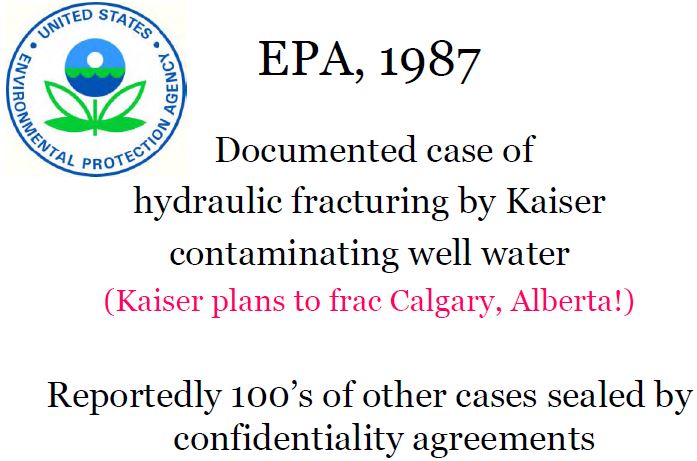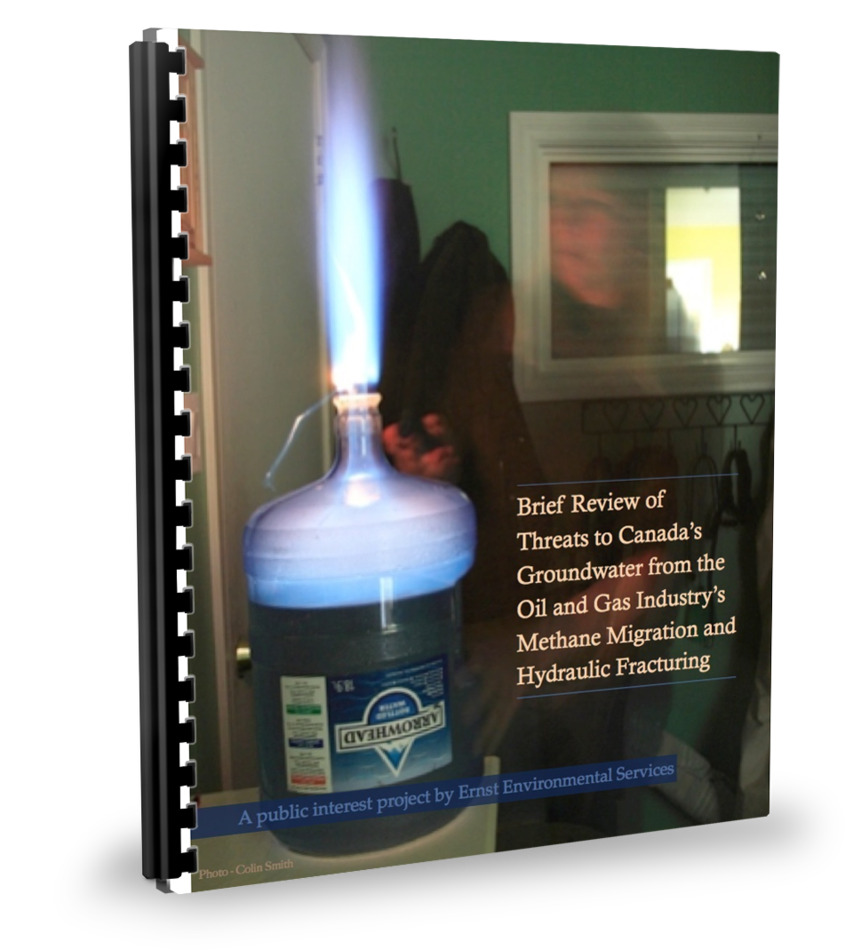McCarthy: EPA fracking assessment expected soon, Advisory board recommends further work on chemical toxicity by David Stegon, 29 November 2016, Chemical Watch Global Risk & Regulation News
The US EPA will release its final assessment on the potential impacts of hydraulic fracturing (fracking) on drinking water resources soon, according to agency administrator Gina McCarthy
Speaking at the National Press Club in Washington, DC on 21 November, Ms McCarthy said she could not disclose what stance the final document would take. However, she said the agency is “certainly going to listen to the advice of the Science Advisory Board,” as laid out in its final assessment of the EPA’s June 2015 draft assessment.
Ms McCarthy said the SAB gave some clear indications that the agency needs to do a better job of explaining the science. [Doesn’t Ms. McCarthy want to admit the SAB essentially reported that the EPA needs to fix its conclusion because it belies the many contamination cases included in the report?] “While I’ve been briefed on it, it is the scientists that will make the decisions,” she added. [Really? Or is it industry CEOs and politicians that make the decisions and control the regulator’s final report?]
The most notable recommendation focuses on chemical toxicity and hazard. The SAB recommends the EPA compile toxicological information on substances such as chemicals, dissolved compounds and ions, and particulates employed in hydraulic fracturing in a more inclusive manner.
The SAB said this section should not limit the selection of hydraulic fracturing constituents of concern to only those that have non-cancer oral reference values (RfVs) and cancer oral slope factors (OSFs) that were peer reviewed by a governmental or intergovernmental source in earlier drafts.
Instead, it should also include a broad range of toxicity data. This should include information pertinent to subchronic exposures from sources cited by the SAB.
Other areas the Board named for improvement are:
- increased clarity of, and support for, major findings in the document’s executive summary, namely in making nationwide conclusions based on insignificant data;
- a sharper focus on the local impacts of hydraulic fracturing, which “have the potential to be severe”;
- including an explanation on why the EPA did not conduct various field studies and other research, as it had planned to do [Industry bullied the EPA and disallowed them to do field studies! Important questions to answer include why did industry do this, and why did a national regulator allow industry to bully away the most important parts of the EPA’s frac study? Because industry and the EPA know how harmful fracing is, and that real studies would prove it? Read Andrew Nikiforuk’s book Slick Water to learn the gritty details of how much they knew and how long ago)]; and
- distinguishing between hydraulic fracturing substances injected into a hydraulic fracturing well compared to substances that come out of hydraulic fracturing wells in produced fluids.
Reporting rule
The EPA plans to issue a notice of proposed rulemaking for reporting obligations by June 2018. This will allow it to obtain data on hydraulic fracturing chemical substances and mixtures. [Rules to be proposed two years later? Is that to wait until industry contaminates all aquifers so that proposed “baseline” water well and aquifer monitoring in post-frac’d America will show methane, ethane, and other hydrocarbons and man-made drilling, cementing, perforating, fracing, servicing chemicals as “naturally” occurring everywhere so that all future industry harm and pollution can continue uninterrupted and without legal recourse? How many more years of “regulation by deregulation” enabled by endless promises to propose “rules” are harmed families and communities to wait?]
The agency says that the mechanism for getting data could be regulatory (under section 8 of TSCA), voluntary, or a combination of both. The proposed rule may include [unenforceable, legally immune] best management practices, third-party certification and collection, and incentives for disclosure of this information.
The agency issued an advanced notice of proposed rulemaking to solicit input in May 2014. It received more than a quarter of a million comments in response. [Emphasis added]
[Refer also to:

Slide from Ernst presentations. More details below.
A brief Timeline of the EPA’s delays (to enable the frac frenzy abuses and harms?) releasing their Final Frac Report:
2004: EPA admits frac risks to aquifers (read Chapter 3)
2010 03 18: EPA frac study and eventual rules promised
The U.S. Environmental Protection Agency (EPA) announced that it will conduct a comprehensive research study to investigate the potential adverse impact that hydraulic fracturing may have on water quality and public health.
…
Hydraulic fracturing is a process that drills vertical and horizontal cracks underground that help withdraw gas, or oil, from coalbeds, shale and other geological formations. While each site is unique, in general, the process involves vertical and horizontal drilling, taking water from the ground, injecting fracturing fluids and sands into the formation, and withdrawing gas and separating and managing the leftover waters.
2011 April: Ernst versus Encana (AER and Alberta government) lawsuit goes public
2011 05 09: Duke Study #1 reported 17x more methane in groundwater near drilled and frac’d wells
2011 November: EPA Study Delayed
2012 editions of Ernst’s paper on water contamination cases caused by hydraulic fracturing submitted to:
The New York Department of Environmental Conservation, January 11, 2012
The Québec Évaluation Environnementale Stratégique (ÉES) sur le Gaz de Schiste, January 15, 2012
2013 edition of Ernst’s paper submitted to:
2013 06 14: ERCB (later pupated into AER) closes the Campbell’s (Alberta ranchers) drinking water contamination investigation after 8 years of investigation
2013 06 16: BC Tap Water Alliance, FrackingCanada and Ami(s) du Richelieu broadcast the EES Gas Migration paper globally
2013 06 17: EES Gas Migration paper submitted to Dr. John Cherry’s Council of Canadian Academies expert panel that supposedly was to review frac’ing. Panel ignored Ernst’s paper completely in their final report (released April 30, 2014) and ignored the most damning research and evidence Ernst summarized for the “expert” panel. Cherry’s frac panel also lied in their final report:
!!!
“But there is in fact a documented case, and the E.P.A. report that discussed it suggests there may be more. … The E.P.A.’s 1987 report does not discuss the specific pathway that the fracking fluid or gel took to get to Mr. Parsons’ water well in West Virginia or how those fluids moved from a depth of roughly 4,200 feet, where the natural gas well was fracked, to the water well, which was about 400 feet underground. …
This well was fracked using gas and water, and with far less pressure and water than is commonly used today. … “The evidence is pretty clear that the E.P.A. got it right about this being a clear case of drinking water contamination from fracking,” said Dusty Horwitt, a lawyer…who investigated the Parsons case. …
Mr. Parsons said in a brief interview that he could not comment on the case. Court records indicate that in 1987 he reached a settlement with the drilling company for an undisclosed amount.”
Article excerpts above with emphasis added, from: A Tainted Water Well, and Concern There May Be More by Ian Urbina, August 3, 2011, New York Times
Excerpt below from The New York Times 2011 Drilling Down Documents:
“This is a 1987 report to Congress by the Environmental Protection Agency that deals with waste from the exploration, development and production of oil, natural gas and geothermal energy. It states that hydraulic fracturing, also called fracking, can cause groundwater contamination. It cites as an example a case in which hydraulic fracturing fluids contaminated a water well in West Virginia. The report also describes the difficulties that sealed court settlements created for investigators.“
Snap below taken from the 1987 EPA report:

Cover of the 1987 EPA Report
June 17, 2013: Wheatland County Council
June 18, 2013: Rocky View County Council
June 26, 2013: UK Lancashire County Council
2013 06 18: US EPA announces 2 year delay of frac study, erodes its comprehensiveness
2013 06 20: US EPA pulls out of Pavillion water contamination investigation after 4 years; Encana takes over with $1.5 million donation
2013 06 24: Duke Study #2 on drilling and frac’ing causing methane contamination of groundwater affirms Study #1 (refer above)
2015: EPA’s Draft report finally released, admits industry frac’s and contaminates drinking water aquifers, listing numerous cases including Rosebud, Alberta, but concludes – in contradiction to the scientific evidence included in the report – no widespread harm to groundwater.
2016 November: EPA’s final frac report promised “soon.”
Refer also to:
2016 08 16: EPA Science Advisory Board: Agency’s Fracking Study Ignored Significant Water Contamination Cases = The Energy Regulator Way? ]


